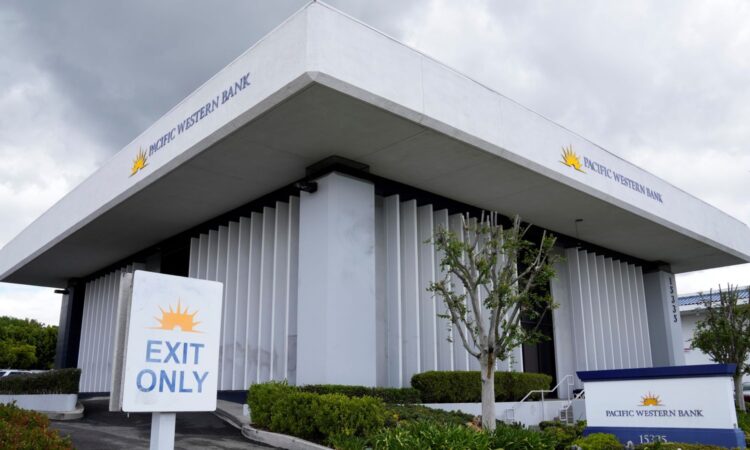
The US banking crisis continues to deepen despite assertions by Federal Reserve Chairman Jerome Powell on Wednesday that the turmoil surrounding regional banks had been brought under control.
Asked at a press conference whether the regional bank situation was at an early or late stage, Powell replied that the issues with the three major banks at the “heart of the stress” had been resolved with the protection of all depositors, and the sale of First Republic was “an important step toward drawing a line under that period of stress.”
It took less than 24 hours for that happy scenario to be torn apart as the official fiction that the US banking system is “sound and resilient” was further exposed.
The next phase of the crisis began on Wednesday, only hours after Powell’s remarks, when shares in the California-based bank PacWest plunged 50 percent in after-hours trading on reports that the company was considering selling itself.
The selloff extended yesterday as PacWest shares dropped to $3.17, their lowest level on record, having lost 85 percent since the SVB crisis started on March 8.
Other regional banks also came under heavy selling pressure. The shares of the Memphis-based bank First Horizon fell by 33 percent, as Canada’s TD Bank said its planned $13.5 billion acquisition of the bank had been scrapped because of uncertainty about regulatory approval.
The shares of Western Alliance, a bank based in Arizona, fell 39 percent on reports, which it strenuously denied, that it was exploring the possibility of a sale.
The KBW Nasdaq regional bank share index dropped by 3.5 percent yesterday, bringing its total fall since the start of the crisis in March to around 30 percent.
The plunge in PacWest shares is particularly significant because, according to the Financial Times, more than three-quarters of its lending is in real estate, which is being hard hit by the interest rate hikes of the past year.
The crisis began with a bank run at SVB because of the loss in market value of Treasury bonds it had accumulated when it was flush with cash during the period of the Fed’s ultra-low interest rates.
There are now warnings that the fall in share prices is setting off a new dynamic that leads to depositors deciding to withdraw their money.
An article in the Wall Street Journal noted that “continued pressure” showed how hard it might be to stop the downward spiral in regional banks, even in cases where they were making healthy profits, because the fall in share prices unnerved investors.
As one analyst told the WSJ: “That’s when it becomes dangerous. When they see this chain of events happen, the natural question becomes, am I good, am I covered?”
The crisis goes far beyond the firms that have gone down so far and reaches into the heart of the US banking system. Its extent was laid out in an article by Ambrose Evans-Pritchard of the London-based Telegraph, drawing on research by banking experts at the Hoover Institution.
“The second and third biggest banking failures in US history have followed in quick succession,” he wrote. “The US Treasury and Federal Reserve would like us to believe that they are ‘idiosyncratic.’ That is a dangerous evasion.”
According to the research, led by Professor Amit Seru of Stanford University, almost half of America’s 4,800 banks are running on negative equity, because of the fall in the market value of their assets.
“It’s spooky. Thousands of banks are underwater,” he said. “Let’s not pretend that this is just about Silicon Valley Bank and First Republic. A lot of the US banking system is potentially insolvent.”
The research found that around 2,315 US banks are holding assets worth less then their liabilities and the market value of their loans is probably $2 trillion lower than their stated book value.
According to Seru, one of the 10 banks most at risk is globally significant with assets of more than $1 trillion. “It is not just a problem for banks under $250 billion that didn’t have to pass stress tests,” he said.
The point could be added that the stress tests imposed on the larger banks, part of the so-called reforms introduced after the 2008 crisis, did not include the ability of banks to withstand a rapid rise in interest rates, the effects of which are now passing through every area of the financial system.
The Evans-Pritchard article noted that while First Republic lent to technology start-ups, it “chiefly came unstuck on commercial real estate.” It would “not be the last on that score,” with “office blocks and industrial property… in the early stage of a deep slump,” he wrote, citing comments by Jeff Fine, global head of real estate at Goldman Sachs.
“Where we stand today is a nearly perfect storm,” Fine said.
“Rates have gone up 400 to 500 basis points in a year,” he said, “and financing markets have almost completely shut down. We estimate there’s $4-5 trillion of debt in the commercial (property) sectors, of which about $1 trillion is maturing in the next 12 to 18 months.”
The article said the attempt to blame the crisis on “miscreant banks” was a “false narrative” because the root cause of the crisis was the shift by the Federal Reserve from ultra-easy to ultra-tight monetary policies.
“They first created ‘interest rate risk’ on a galactic scale: now they are detonating the delayed time bomb of their own creation.”
According to Chris Whalen of Institutional Risk Analyst: “The Fed’s excessive open market intervention from 2019 through 2022 was the primary cause of the failure of First Republic as well as Silicon Valley Bank.”
That intervention, which lifted quantitative easing (QE) programs initiated in the wake of the 2008 crisis to new heights, was initiated to halt the market meltdown of 2020 at the start of the pandemic, when it was feared that the stock market and financial bubble, created by the previous round of QE, would collapse. It halted the immediate crisis but sparked a new round of speculation.
According to Whalen, banks and bond investors, such as pension funds and insurance investors, have been left “holding the bag” for the implicit losses of $5 trillion resulting from the end of QE and the rise of interest rates, which has cut the market value of all financial assets.
“Since the US banks have only about $2 trillion in tangible equity capital, we have a problem,” he said.
Whalen predicted the financial crisis would continue to develop until the Fed backed off and moved to cut interest rates.
But such a turn could see another factor intervene—a dollar crisis.
For decades, the US has been able to create a seemingly unending supply of money to finance budget deficits, bloated not least by the escalating spending on the military, as well as laying out trillions in monetary support for the stock market and financial system.
It has been able to do what is not possible for any other government because of the role of the dollar as the global currency. But its dominance is increasingly being called into question, reflected in the rise in the price of gold, the ultimate store of value, to new highs over recent months.
As a fiat currency, one which is not backed by a material store of value, the dollar rests on confidence in the US government.
But that too is being undermined as the toxic civil war within the US political establishment has now led to a debt ceiling conflict in Congress. If the ceiling is not lifted from its present level of $31.4 trillion, the Treasury may be unable to pay its bills, possibly by as early as June 1.
This would lead to a situation where the value of US Treasury bonds, supposedly the safest financial asset in the world, would be called into question with potentially incalculable financial and economic consequences.






